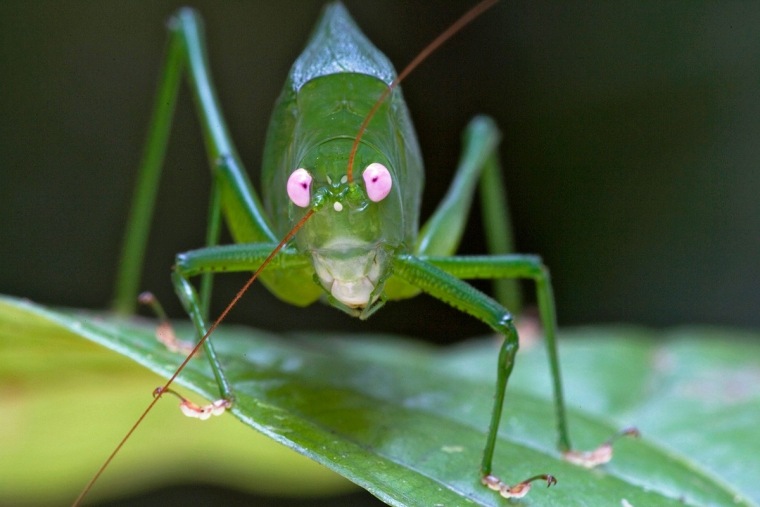Conservationists are celebrating the discovery of more than 200 new species in the remote mountains of Papua New Guinea, ranging from flowers to frogs to mice.
The island of New Guinea and its surroundings have been a biological gold mine for more than a century, going back to the expeditions of Alfred Russel Wallace, a pioneer in evolutionary biology and contemporary of Charles Darwin who cataloged hundreds of species throughout the Malay Archipelago.
Most recently it's been a gold mine of discoveries for Conservation International, a nonprofit group that monitors biodiversity around the world. The group has helped organize a series of "rapid assessment projects" in Papua New Guinea on the east side of the island, as well as Indonesian New Guinea on the west side. Hundreds of new species have been discovered as a result, building CI's case for greater protection of the island's biological riches.
The newly announced finds were made during two expeditions conducted last year in the remote Nakanai Mountains on the island of New Britain, and the Muller Range on New Guinea. CI's researchers were accompanied by partners from Papua New Guinea's Institute for Biological Research and A Rocha International. Among the modes of transportation required to get to the sites were a small plane, a dinghy, a helicopter ... and hiking boots.
The roll call of new species includes 24 types of frogs, two types of mammals, nine varieties of plants (including a spectacular new kind of rhododendron), nearly 100 types of insects and 100 species of spiders. The most memorable creatures included a beautiful yellow-spotted frog, a curious-looking long-tailed mouse, an emerald-green katydid and another bug with bugged-out pink eyes. You can see all of those new species and more in our Papua New Guinea slideshow.
Harvard University entomologist Piotr Naskrecki used sophisticated audio equipment to track down katydids by listening for their nocturnal chirps. He found five to 10 new katydid species per night.
"In some cases, nearly 80 percent of what I found was new to science," Naskrecki told Live Science's Stephanie Pappas. "Almost every species I collected was new, or it was something that had not been seen for 100 years or so. To me, it was like landing on another planet."
The expeditions are aimed at documenting the diversity of environmental hotspots, particularly in wild places that have not yet been hit by deforestation. In the Nakanai Mountains, Conservation International is working with the East New Britain provincial government and local communities to protect a large tract of rainforest from logging. After last year's surveys, community leaders from the Nakanai as well as the Muller Range said they'd be willing to participate in forest protection projects.
United Nations
The Muller Range is in Papua New Guinea's Southern Highlands, while the Nakanai Mountains are in East New Britain province.
"With both the Nakanai Mountains and the Muller Range on UNESCO's World Heritage Tentative List, we hope that news of these amazing new species will bolster the nomination of these spectacular environments for World Heritage status, " Conservation International's Stephen Richards said in a statement.
This month, conservationists from around the world are gathering in Japan for a high-level meeting related to the Convention on Biological Diversity. CI says it will support the goal of protecting at least 25 percent of Earth's land and inland waters and 15 percent of marine ecosystems by 2020.
"There's no question that the discoveries we made in both surveys are incredibly significant both for the large numbers of new species recorded, and the new genera identified," Conservation International's Leeanne Alonso said. "While very encouraging, these discoveries do not mean that our global biodiversity is out of the woods. On the contrary, they should serve as a cautionary message about how much we still don't know about Earth's still hidden secrets and important natural resources, which we can only preserve with coordinated, long-term management."
More on biodiversity:
- Scientists finish first sea census
- Amphibians wanted ... alive
- Three 'lost' amphibians found
- Deep-sea creatures of the Coral Sea
- The top 10 new species from 2009
- Beautiful biodiversity in Brazil
- New Guinea's 'Lost World' revisited
- Indonesia's 'Garden of Eden'
- Marine marvels from Papua New Guinea
- Biological treasures from Borneo
- Celebrities of the Celebes Sea
- 12 froggy finds from India
- Fantastic frogs from Colombia
- Aliens lurk in Antarctic depths
- The strange species of Suriname
- Vulnerable new species in Brazil
- Discoveries from Vietnam's 'Green Corridor'
- Endangered species of the Mekong Delta
- New species from Australia's coral reefs
- Thousands of new species in ocean's depths
- Hundreds of new species amid the Himalayas
- New species found Down Under .. underground
- Eight 'extinct' species found alive and kicking
Visit the brand-spanking-new Cosmic Log page on Facebook and hit the "Like" button. You can also follow @boyle on Twitter. And if you really want to be friendly, ask me about "The Case for Pluto."
